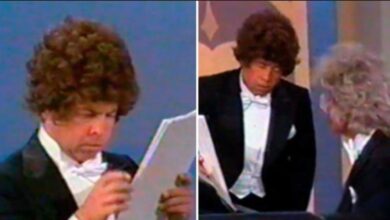Roy Orbison’s “Only the Lonely” Redefined Heartache and Shaped Pop’s Emotional Core in 1960
When Roy Orbison released “Only the Lonely” in 1960, it was more than just a hit single—it was a declaration of vulnerability in a genre then dominated by bravado and youthful exuberance. The song’s haunting melody and aching vocals marked a departure from the typical rock and roll fare of the era, introducing listeners to a deeper, more introspective emotional landscape. It climbed to No. 2 on the Billboard Hot 100 and topped the UK Singles Chart, becoming Orbison’s first international success and laying the groundwork for a career that would blend operatic emotion with pop precision.
Roy Orbison was born in Vernon, Texas, in 1936, and his path to stardom was anything but conventional. Unlike many of his contemporaries, Orbison didn’t possess a rock-and-roll swagger or a showman’s confidence. Instead, he cultivated an image of quiet intensity. His early work with the Teen Kings and Sun Records placed him in the company of Elvis Presley and Johnny Cash, but it wasn’t until he signed with Monument Records in the late 1950s that his unique sound began to flourish. His voice—a high, operatic tenor capable of effortless falsetto—would become his trademark, and “Only the Lonely” was its first grand showcase.
The origins of “Only the Lonely” are as poignant as the song itself. Orbison originally pitched the song to Elvis Presley and the Everly Brothers, both of whom turned it down. Undeterred, he decided to record it himself with producer Fred Foster. Co-written with Joe Melson, the lyrics stemmed from Orbison’s own experiences with alienation and loss. He described the track as “a song for the lonely, the lost, the invisible,” capturing a sense of isolation that resonated with countless listeners. It was an anthem not of rebellion, but of resignation—and therein lay its revolutionary power.
Recorded at RCA Studio B in Nashville, “Only the Lonely” featured a sound that would come to define Orbison’s musical identity: lush string arrangements, gentle backup harmonies, and an unhurried tempo that gave room for emotion to bloom. Foster’s production was deliberately minimalist in instrumentation but rich in atmosphere. Orbison’s vocal performance was breathtaking—starting soft and sorrowful before swelling into a high, heartbreaking climax. The “dum-dum-dum-dumdy-doo-wah” refrain became instantly iconic, a melodic signature that added to the track’s dramatic pull.
The song’s release was met with immediate acclaim. In the United States, it peaked at No. 2 on the Billboard Hot 100, held back only by Brenda Lee’s “I’m Sorry.” In the United Kingdom, it soared to No. 1, making Orbison one of the first American artists to enjoy significant transatlantic chart success. It also earned him a gold record, and years later, it would be inducted into the Grammy Hall of Fame. For many critics and fans, “Only the Lonely” marked the true beginning of Orbison’s reign as the master of heartbreak ballads.
Beyond commercial performance, “Only the Lonely” had a profound cultural impact. It introduced a different kind of masculinity into the rock and pop canon—one that embraced vulnerability, emotional depth, and the kind of yearning previously reserved for torch singers. Orbison’s tear-streaked tenor cut through the posturing of his peers, offering something rare and essential: sincerity. In a musical era often dominated by dancefloor-friendly anthems, Orbison sat solemnly in the shadows and gave sadness a beautiful sound.
The song’s success changed the trajectory of Orbison’s career. No longer relegated to the fringes of rockabilly or rock and roll, he was now seen as a leading figure in a new kind of pop music—melodramatic, deeply expressive, and vocally demanding. It led to a string of follow-up hits including “Crying,” “In Dreams,” and “Running Scared,” each exploring new emotional territory while refining the sonic palette first unveiled in “Only the Lonely.” Orbison’s image—dark sunglasses, still posture, and mournful voice—became iconic.
“Only the Lonely” also left an indelible mark on the broader music landscape. It helped set the stage for the orchestral pop ballads of the 1960s and influenced a generation of artists who would seek to blend rock instrumentation with classical elements. Its emotional honesty paved the way for the introspective songwriting of artists like Paul McCartney, Chris Isaak, and even Bruce Springsteen, who cited Orbison as a major influence. The song was a precursor to the confessional style that would dominate singer-songwriter and soft rock genres in the decades to come.
Many artists have paid tribute to “Only the Lonely” through covers and live renditions. The most notable perhaps is Chris Isaak, whose song “Wicked Game” draws heavily from Orbison’s vocal and emotional style. K.D. Lang, Glen Campbell, and even Tom Petty have cited Orbison—and particularly this track—as a blueprint for emotional clarity in songwriting. Each interpretation underscores how “Only the Lonely” functions as more than just a hit; it’s a universal expression of sorrow.
When Orbison returned to prominence in the late 1980s as part of the Traveling Wilburys, “Only the Lonely” was often mentioned as the song that started it all. By then, he had experienced personal tragedy—including the deaths of his wife and two sons—and his music took on an even deeper gravity. Yet “Only the Lonely” remained untouched in its original form, a pure distillation of longing and despair that seemed eerily prophetic.
The song’s lasting legacy is evident in its continued relevance. It’s still played on oldies radio stations, featured in film soundtracks, and included in retrospectives of the greatest songs of the 20th century. It has been honored by the Grammy Hall of Fame and listed among Rolling Stone’s “500 Greatest Songs of All Time.” More importantly, it remains a song that feels deeply personal, no matter how many times it’s heard.
“Only the Lonely” also reshaped the sonic blueprint for emotional pop. It showed that complex feelings could be conveyed through understated instrumentation and vocal restraint, influencing the production of countless ballads in the decades that followed. Its structure—a slow build, a dramatic climax, a soft landing—has become a model for how to write and produce a truly affecting song.
In 1989, just months before his death, Roy Orbison was inducted into the Rock and Roll Hall of Fame, a fitting tribute to a man who brought emotional transparency to the forefront of popular music. “Only the Lonely” was cited among the reasons for his induction, a reminder of the song’s pivotal role in shaping modern pop expression.
More than six decades after its release, “Only the Lonely” continues to stand as a monument to the beauty of sorrow. It is a song that doesn’t just speak to heartbreak—it inhabits it, giving voice to the emotions many fear to express. In doing so, Roy Orbison created not just a classic, but a cornerstone of musical vulnerability.





